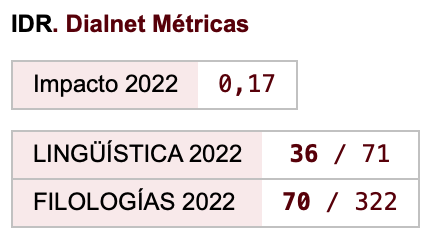The film trailer and subtitling in language teaching: Practical application in the German-Spanish language combination
Keywords:
direct subtitling, reverse subtitling, movie trailer, audiovisual translation, advertisingAbstract
This article describes a teaching experience carried out in the lectures of language for translators in the Degree of Translation and Interpreting at the Universidad de Alicante during the courses 2014-2015 and 2015-2016. The practice of both direct and reverse subtitling was used as a language learning strategy in the subject “Contrastes lingüísticos y culturales de la Lengua B (Alemán)”. Practical exercises were done by using the subtitling program Subtitle Workshop 2.51, while the theoretical knowledge related to this audiovisual mode was extracted from a reference manual in German language (Jüngst, 2010), from which notes and a glossary in German had been elaborated for this specific purpose. The results of the evaluation by the students based on a survey, for both 2014-2015 and 2015- 2016 editions, show their satisfaction. Students pointed out their interest for subtitling, as well as for the selected genre, which is proposed here as a most appropriate one for the desired didactic objectives. As mentioned above, this experience took place at the Universidad de Alicante, although the subtitling workshop was given by a lecturer from the Universitat Jaume I in Castellón.
Downloads
References
Bueno García, A. (2000). Publicidad y Traducción. Soria: Vertere, Monográficos de la revista Hermeneus, no 2.
Chaume, F. & Martí Ferriol, J.L. (2014). Teaching advertising translation: A didactic proposal. Linguae - Revista de la Sociedad Española de Lenguas Modernas, 1, 75-98.
Danan, M. (2004). Captioning and subtitling: Undervalued language learning strategies. Meta, 49(1), 67-77.
Dornaleteche Ruiz, J. (2007). Definición y naturaleza del trailer cinematográfico. Pensar la publicidad, 1(2), 99-116.
Gambier, Y., Caimi, A. & Mariotti, C. (Eds.). (2014). Subtitles and Language Learning Principles, strategies and practical experiences. Bern, Berlin, Bruxelles, Frankfurt am Main, New York, Oxford, Wien: Peter Lang.
Hesford, D. (2013). ‘Action!... Suspense!... Emotion!’ The trailer as cinematic performance.
Frames Cinema Journal <http://framescinemajournal.com/article/action-suspense- emotion-the-trailer-as-cinematic-performance/>.
Jensen, C. S. (2014). Reduced Narration, Intensified Emotion: The Film Trailer. Projections, 8(1), 105-125.
Jüngst, H. (2010). Audiovisuelles Übersetzen: Ein Lehr- und Arbeitsbuch. Tübingen: Günter- Narr.
López Font, L. & Correia Baptista, C. M. (2011). Hibridación y generación de contenido en los tráileres y la comunicación on-line de Toy Story 3: Un ejemplo de objetivos multidimensionales. Actas IV Congreso Internacional sobre Análisis Fílmico. Nuevas tendencias e hibridación de los discursos audiovisuales en la cultura digital moderna. Universitat Jaume I de Castellón, Castellón 4-6 mayo de 2011. Madrid: Ediciones de Ciencias Sociales. <http://repositori.uji.es/xmlui/handle/10234/31256>.
Martínez Puche, S. (2008). El tráiler de cine: entre el spot publicitario y la demostración narrativa. Revista Nau de Comunicação Audiovisual, 1(2), 59-81.
Montes Férnandez, A. (2007). Traducción y globalización. Análisis y perspectivas del fenómeno publicitario (Inglés-Español-Alemán). Granada: Comares.
Neves, J. (2004). Language awareness through training in subtitling. In P. Orero (Ed.), Topics in Audiovisual Translation (pp. 127-140). Amsterdam, Philadelphia: John Benjamins.
Talaván Zanón, N. (2006). Using Subtitles to Enhance Foreign Language Learning. Porta Linguarum: revista internacional de didáctica de las lenguas extranjeras, 6, 41-52.
Valdés Rodríguez, C. (2004). La traducción publicitaria: Comunicación y Cultura. Valencia: Universitat de Valéncia, Servei de Publicacions.
Downloads
Published
How to Cite
Issue
Section
License
Authors who publish with this journal agree to the following terms:
- Authors retain copyright and grant the journal right of first publication with the work simultaneously licensed under a Creative Commons Attribution License that allows others to share the work with an acknowledgement of the work's authorship and initial publication in this journal.
- Authors are able to enter into separate, additional contractual arrangements for the non-exclusive distribution of the journal's published version of the work (e.g., post it to an institutional repository or publish it in a book), with an acknowledgement of its initial publication in this journal.
- Authors are permitted and encouraged to post their work online (e.g., in institutional repositories or on their website) prior to and during the submission process, as it can lead to productive exchanges, as well as earlier and greater citation of published work (See The Effect of Open Access).

Revista de Lenguas para fines específicos is licensed under a Creative Commons Reconocimiento-NoComercial-SinObraDerivada 4.0 Internacional License.























